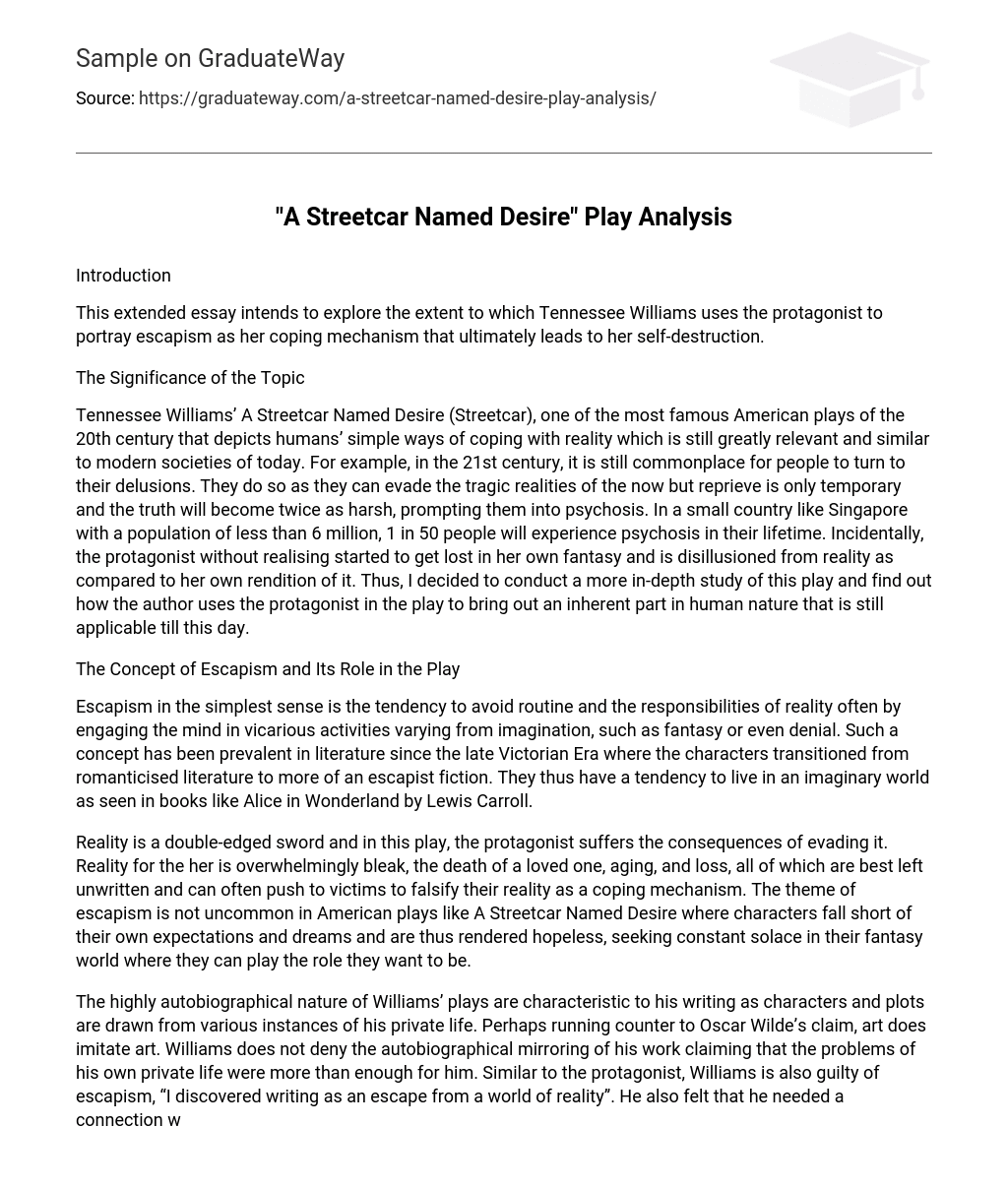Introduction
This extended essay intends to explore the extent to which Tennessee Williams uses the protagonist to portray escapism as her coping mechanism that ultimately leads to her self-destruction.
The Significance of the Topic
Tennessee Williams’ A Streetcar Named Desire (Streetcar), one of the most famous American plays of the 20th century that depicts humans’ simple ways of coping with reality which is still greatly relevant and similar to modern societies of today. For example, in the 21st century, it is still commonplace for people to turn to their delusions. They do so as they can evade the tragic realities of the now but reprieve is only temporary and the truth will become twice as harsh, prompting them into psychosis. In a small country like Singapore with a population of less than 6 million, 1 in 50 people will experience psychosis in their lifetime. Incidentally, the protagonist without realising started to get lost in her own fantasy and is disillusioned from reality as compared to her own rendition of it. Thus, I decided to conduct a more in-depth study of this play and find out how the author uses the protagonist in the play to bring out an inherent part in human nature that is still applicable till this day.
The Concept of Escapism and Its Role in the Play
Escapism in the simplest sense is the tendency to avoid routine and the responsibilities of reality often by engaging the mind in vicarious activities varying from imagination, such as fantasy or even denial. Such a concept has been prevalent in literature since the late Victorian Era where the characters transitioned from romanticised literature to more of an escapist fiction. They thus have a tendency to live in an imaginary world as seen in books like Alice in Wonderland by Lewis Carroll.
Reality is a double-edged sword and in this play, the protagonist suffers the consequences of evading it. Reality for the her is overwhelmingly bleak, the death of a loved one, aging, and loss, all of which are best left unwritten and can often push to victims to falsify their reality as a coping mechanism. The theme of escapism is not uncommon in American plays like A Streetcar Named Desire where characters fall short of their own expectations and dreams and are thus rendered hopeless, seeking constant solace in their fantasy world where they can play the role they want to be.
The highly autobiographical nature of Williams’ plays are characteristic to his writing as characters and plots are drawn from various instances of his private life. Perhaps running counter to Oscar Wilde’s claim, art does imitate art. Williams does not deny the autobiographical mirroring of his work claiming that the problems of his own private life were more than enough for him. Similar to the protagonist, Williams is also guilty of escapism, “I discovered writing as an escape from a world of reality”. He also felt that he needed a connection with the character, a characteristic to identify with, or else the character would just be two-dimensional. Thus, through the characters in his plays, William integrates his own problems while reaching out to his audience. He endows his characters with flesh and blood coupled with poignant anecdotes of his life, pulling the heartstrings of his audience. In plays like Streetcar, Orpheus Descending and Cat on A Hot Tin Roof, the pursuit of happiness is a visceral part of human desire. Longing to be happy. However, in the plays, happiness is unattainable and the character’s quest loses direction, often finding a solution in self-destruction. Happiness and self-destruction may seem to lie on opposite ends of the spectrum but in Williams’ plays, they have a cause and effect relationship. Williams who is a fellow escapist perhaps due to his sister’s sickness causes him to abuse alcohol and substances a means of coping with the stress, similar to the characters in his plays, ultimately leading them to self-destruction. Psychosis for Blanche and for him would be falling out of the limelight in the world of playwright.
In the above mentioned plays, the characters are multifaceted but yet they all share the same primitive urges- to be happy. These characters achieve their goal temporarily but in the end they still have to face their failures. They are unable to come to terms with reality and find a solution in self-ruination. This is especially evident in the protagonist of Streetcar as the protagonist blurs the boundary of reality and illusion to take refuge from her haunting and dark past. Thus, this intriguing concept urged me to investigate how escapism is used to retain an illusion to keep one going but ultimately ends in self-destruction, especially in A Streetcar Named Desire.
In this essay, I will be applying the psychoanalytical literary theory to assess Blanche as a character in the play. This analysis will be done in a chronological order where in her approaches towards escapism are shaped by nuances in her life. Followed by a turning point in her life before she continues own the road and descends into psychosis.





